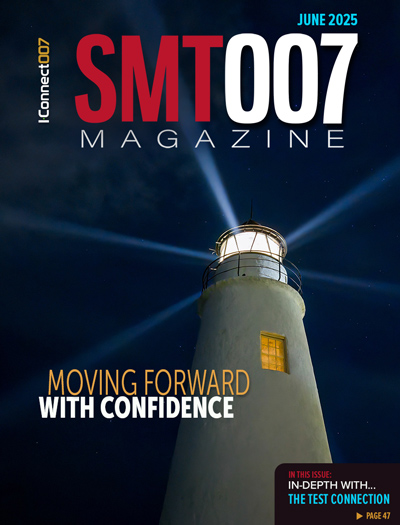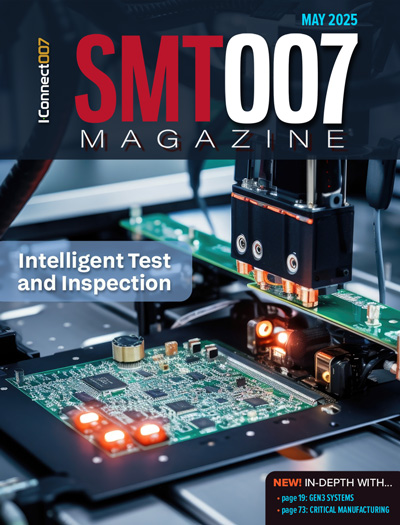-

- News
- Books
Featured Books
- smt007 Magazine
Latest Issues
Current Issue
What's Your Sweet Spot?
Are you in a niche that’s growing or shrinking? Is it time to reassess and refocus? We spotlight companies thriving by redefining or reinforcing their niche. What are their insights?

Moving Forward With Confidence
In this issue, we focus on sales and quoting, workforce training, new IPC leadership in the U.S. and Canada, the effects of tariffs, CFX standards, and much more—all designed to provide perspective as you move through the cloud bank of today's shifting economic market.

Intelligent Test and Inspection
Are you ready to explore the cutting-edge advancements shaping the electronics manufacturing industry? The May 2025 issue of SMT007 Magazine is packed with insights, innovations, and expert perspectives that you won’t want to miss.
- Articles
- Columns
- Links
- Media kit
||| MENU - smt007 Magazine
SEHO Will Introduce Zero-Fault Production at productronica
October 20, 2015 | SEHO Systems GmbHEstimated reading time: 2 minutes
SEHO Systems GmbH, a worldwide leading manufacturer of complete solutions for soldering processes and automated production lines, will highlight zero-fault production in hall A4, booth 578 at the upcoming productronica International Trade Fair, scheduled to take place Nov. 10-13, 2015 at the Messe München exhibition center in Munich, Germany. Innovative solutions and custom-made automation technology demonstrate SEHO’s future viability.
Zero-Fault Production Line with Automatic Rework
Typically, manual rework processes – if allowed at all – are almost non-reproducible and often cannot be performed with the required high quality. In addition, manual rework is time-consuming and cost-intensive, and hidden costs such as productivity rates or staff training need to be considered.
The zero-fault production line from SEHO is designed for selective soldering of through-hole components, free from defects and completely traced. Besides the selective mini-wave soldering process, this production line incorporates automated optical inspection (AOI) of the solder joints, a verify workstation for verification and classification of detected faults as well as a defined and automated rework soldering process according to the respective soldering defect. Intelligent handling units automatically allocate the assemblies to the next work station.
Of course, all modules in this zero-fault production line are linked with a bi-directional data transfer. All process and machine data is completely recorded, analyzed and documented.
Fully reproducible and operator-independent processes, automatic rework of only verified defects, not the entire board, and no influence on the cycle time of the overall system are only a few of the outstanding advantages of this zero-fault production line from SEHO.
Wave Soldering System of the Future
New concepts also are required in the field of wave soldering in order to meet the goal of a defect-free production. For this purpose SEHO developed a new system where all process-relevant components – fluxing, preheating and soldering – have been replaced by new, innovative modules.
To activate the surface of the PCB prior to wave soldering, typically a solvent-based flux is applied. Alternatively, now a plasma process can be used to deposit flux powder, so a solvent can be avoided. Due to reduced residues, product quality and downtime of the system can be improved.
Preheating of PCBs, especially for the increasing share of power electronics, requires a high energy density. This can be implemented efficiently by using new infrared emitters that offer extremely good heat transfer and are only activated in the areas where a PCB is located. This can be achieved by the fast response of the emitters, an exact PCB monitoring system and newly developed software.
For the solder wave, the increasing product mix is a major challenge. To meet this requirement, SEHO developed a dual soldering unit that allows independent temperature settings for the solder and an automotive-compliant separation of different solder materials. The exchange between two solder alloys for two different products can take place in seconds, the unused solder is completely separated from the process chamber.
Suggested Items
Driving Innovation: Direct Imaging vs. Conventional Exposure
07/01/2025 | Simon Khesin -- Column: Driving InnovationMy first camera used Kodak film. I even experimented with developing photos in the bathroom, though I usually dropped the film off at a Kodak center and received the prints two weeks later, only to discover that some images were out of focus or poorly framed. Today, every smartphone contains a high-quality camera capable of producing stunning images instantly.
Hands-On Demos Now Available for Apollo Seiko’s EF and AF Selective Soldering Lines
06/30/2025 | Apollo SeikoApollo Seiko, a leading innovator in soldering technology, is excited to spotlight its expanded lineup of EF and AF Series Selective Soldering Systems, now available for live demonstrations in its newly dedicated demo room.
Indium Corporation Expert to Present on Automotive and Industrial Solder Bonding Solutions at Global Electronics Association Workshop
06/26/2025 | IndiumIndium Corporation Principal Engineer, Advanced Materials, Andy Mackie, Ph.D., MSc, will deliver a technical presentation on innovative solder bonding solutions for automotive and industrial applications at the Global Electronics A
Fresh PCB Concepts: Assembly Challenges with Micro Components and Standard Solder Mask Practices
06/26/2025 | Team NCAB -- Column: Fresh PCB ConceptsMicro components have redefined what is possible in PCB design. With package sizes like 01005 and 0201 becoming more common in high-density layouts, designers are now expected to pack more performance into smaller spaces than ever before. While these advancements support miniaturization and functionality, they introduce new assembly challenges, particularly with traditional solder mask and legend application processes.
Knocking Down the Bone Pile: Tin Whisker Mitigation in Aerospace Applications, Part 3
06/25/2025 | Nash Bell -- Column: Knocking Down the Bone PileTin whiskers are slender, hair-like metallic growths that can develop on the surface of tin-plated electronic components. Typically measuring a few micrometers in diameter and growing several millimeters in length, they form through an electrochemical process influenced by environmental factors such as temperature variations, mechanical or compressive stress, and the aging of solder alloys.


